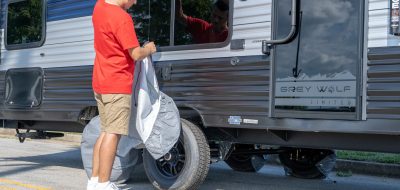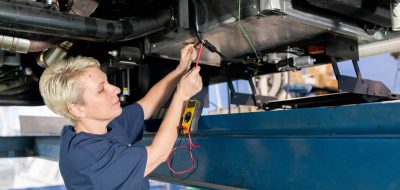 Courtesy of Good Sam Emergency Road Service (ERS)
Courtesy of Good Sam Emergency Road Service (ERS)
Fault indicators are your vehicles way of letting you know there is a malfunction in one of the onboard systems. The check engine, or service engine soon, light can illuminate for various reasons—some are immediate concerns, but most are emissions related and will not affect performance or cause damage.
Your Cummins diesel engine is being constantly monitored by a various sensors and circuits. These sensors produce signals that are interpreted by the engine computer or engine control module (ECM). The engine computer expects to see certain signal ranges. If the signal ranges are not as expected, a fault will be logged. These signals are monitored constantly by the Cummins ECM.
If a malfunction has occurred, but is not present on the malfunction indicator lamp (MIL), the ECM will store an inactive fault or history code. If the malfunction is current, an active fault code is stored, and the MIL will illuminate or flash. A flashing MIL indicates a serious malfunction, and you should cease operation as soon as safely possible.
How do you know if it is safe to continue operation?
You have to communicate with the ECM, and ask it to tell you what is happening. You can do this by pulling the fault codes. Here’s how:
Procedure for retrieving fault codes on Dodge 6.7 Cummins trucks:
- Select “total miles” on the trucks odometer, not trip.
- Insert ignition key.
- Move the key from LOCK TO OFF, THEN PAUSE.
- Move ignition key to ON/RUN.
- Move ignition key BACK TO OFF.
- Move ignition key to ON/RUN.
- Move ignition key BACK TO OFF.
- Move ignition key to ON/RUN and STOP THERE!
The Key cycles from OFF to ON/RUN should be done in less than 5 seconds.
You then can read the codes on the truck’s odometer. (See complete list below.)
Once you have pulled the codes, contact your Good Sam ERS, and ask to speak to a technician. The tech will be able to advise you on the possibilities and offer further guidance. Once you know the problem, you will have a better idea if you want to work on the repairs yourself or take it to a qualified professional.
ISB fault codes:
A complete list of all Dodge Cummins ISB (5.9 & 6.7L)
- 111 Electronic Control Module ECM Microprocessor
- 115 Engine Speed Sensor ESS Circuit
- 121 Engine Position Sensor EPS Circuit
- 122 Intake Manifold Pressure Sensor Circuit
- 123 Intake Manifold Pressure Sensor Circuit
- 124 Intake Manifold Pressure – Engine Protection
- 131 Accelerator Position Sensor Circuit
- 132 Accelerator Position Sensor Circuit
- 135 Oil Pressure Sensor Circuit
- 141 Oil Pressure Sensor/Switch Circuit Choice
- 141sn Oil Pressure Sensor Circuit
- 141sw Oil Pressure Switch Circuit
- 144 Coolant Temperature Sensor Circuit
- 146 Coolant Temperature – Engine Protection
- 153 Intake Manifold Air Temperature Sensor Circuit
- 154 Intake Manifold Air Temperature Sensor Circuit
- 186 Wait-to-Start Lamp Circuit
- 211 Vehicle Electronic Control Module
- 234 Engine Overspeed Circuit
- 261 Fuel Temperature Sensor Circuit
- 264 VP44 Fuel Temperature Sensor Error
- 278 Lift Pump Circuit
- 283 Engine Speed Sensor Supply
- 284 Engine Speed Sensor Supply
- 291 Datalink Circuit
- 334 Coolant Temperature Sensor Circuit
- 352 Sensor Supply Circuit
- 362 VP44 Fuel Valve High Current Error
- 363 VP44 Fuel Pump Control Valve Feedback Error
- 364 Electronic Control Module ECM to Pump Communications Error
- 365 Fuel Pump Voltage Out of Range Error Low
- 366 VP44 Fuel Pump Voltage Measurement Error
- 367 VP44 Fuel Pump Speed/Position Sensor Signal Lost
- 368 VP44 Fuel Pump Can Not Reach Commanded Timing
- 369 VP44 Fuel Pump To Engine Synchronization Pulse Not Recognized
- 372 Idle Select High/Low
- 373 VP44 Fuel Pump Fuel Shut Off Error
- 374 VP44 Fuel Pump Calibration Error
- 375 Electronic Control Module ECM Fuel Calibration Corrupted
- 376 VP44 Fuel Pump rpm and Fuel Error
- 377 Fuel Pump Power Relay Stuck-On
- 381 Intake Air Heater Relay Circuit
- 382 Intake Air Heater Relay Circuit
- 383 Intake Air Heater Circuit
- 386 Sensor Supply Circuit
- 387 Accelerator Position Sensor Circuit
- 391 VP44 Relay Coil Supply Circuit
- 418 Water-In-Fuel Sensor Circuit
- 429 Water-In-Fuel WIF Sensor Circuit
- 431 Idle Validation Switch IVS Circuit
- 432 Accelerator Pedal Circuit ISS
- 433 Intake Manifold Pressure Sensor Circuit
- 441 Unswitched Battery Supply Circuit
- 442 Unswitched Battery Supply Circuit
- 443 Accelerator Position Sensor Circuit
- 517 VP44 Fuel Pump Valve Feedback Error
- 613 Engine Misfire Detection
- 621 Engine Misfire Detection
- 622 Engine Misfire Detection
- 623 Engine Misfire Detection
- 624 Engine Misfire Detection
- 625 Engine Misfire Detection
- 626 Engine Misfire Detection
- 768 Output Device Driver Transmission Shift Modulation
- 779 OEM Input – Engine Protection
Written by your Good Sam RV technician JD





R, Dick
I purchased an /01 5.9 cummins turbo d. new. After 10 yrs. driving & 132,00km. It developed a surge @ approx. 30km.p.hr. Dealer checked problem , said should repl. throttle control. I took truck to my servicco., relaced throttle contr. but did not fix surging. They repl. other parts with final bill at $1800. Drove truck for a day, still surging. I went on net & asked dodge mechanics if they ever encounterred a surging problem. one emailed me with a solution. I paid him $28 . Was told to remove all battery cables & clean them up. Problem solved. Note I went back to esrve co. that replace a lot of other pats, I told them how problem was fixed & I asked if they would reimburse me for some of their costs? They agreed & replaced my font end upper & lower balljounts for free. Now I am a happy cummins owner again. [Seemed Odd that Dodge dealer didn”t know of this fix].
Bert
WOW:
Thanks guys! You just saved me from buying a new Dodge or GM Diesel truck. I surely don’t to go through all the kind of problems you’ve had with uncaring and untrained mechanics. That sure reflects badly upon the corporations and their overpaid management teams! I already know better than to consider the Ford Powder Stroke.
Although I can’t get as good MPG or the torque – I think I’ll stick with a gasoline vehicle and probably buy something I can depend upon – like a TOYOTA! Guess I’ll just have to install a ‘kill switch’ to keep the gas peddle from sticking to the floor! ha ha (into the turn with NO CONCERN)!! YEEHAAAA!
B
Fred K
Have four 5.9’s in the company fleet, no problems. A couple have 170k and 200k with only normal maintainence.
Yes there were some problems with the 6.7’s emission and rengeneration lcontrols and my personal ’07 2500 truck was in the shop four times: computer flash, DPF (diesel particulate filter) replacement by dealer and turbo replacement,,, did the DPF delete and smarty chip (Approx $800), wow, what a difference! At the +100HP and 2nd torque settings I still get 20-22mpg highway and 12mpg towing two jeep trailer, 10k lbs.
I acknowledge you shouldn’t have to go to the expense or trouble to get your truck running right and several friends with ’09 and later models haven’t had any similar problems.
Haven’t had any trouble with the Cummins ISC in the motorhome.
Dave Stoeffler
Sounds like Steve had a lemon. I have a 2004 model Cummins and have had few problems. This truck has been all over North America and runs like a top.
Scott Burdick
Thought I would share my recent frustrations with my 2004 Silverado 2500HD. Perhaps there are others out there who have already experienced what I have just recently found out about General Motors (GM) poor quality control on their exhaust manifold bolts. I bought this truck less than two years ago as a tow vehicle planning ahead for the purchase of a travel trailer. I developed an exhaust leak near the engine and found out I had a broken bolt on the drivers side rear. My mechanic suggested the only way to repair was to remove the head and drill out the broken bolt. Lots of money needed for what amounts to a poor quality two dollar bolt. I now know GM has had this problem on the V8 engines from 1999 to 2007. No recalls, only a TSB through the 2003 model year but it appears they continued to use the same defective parts post 2003. Guess they expect the owners to foot the bill for their poor quality control and defective parts. Not to mention that an authorized dealership can sell this previously owned vehicle without informing the buyer of this expensive repair. I have filed complaints with the NHTSA, GM, EPA and the dealership where I purchased the truck. No response from any to date.
randy t
I had code 191 fuel problems. Dodge had the truck for 3 days and could not find the problem. they up grades the computer software and no problems so far. This happen about 3 weeks ago.
Steven Galloway
6.7 dodge ram diesel 2500 2008 model
I had to sell mine as every 4000 mile it spent 3-4 days to 2 weeks in the shop with the engine light on.
Dodge replaced the egr, turbo, the fuel pump, filters and anything else to keep from addressing the real problem. I sold my truck with 40,000 miles. Each trip to the shop cost me $300-$600 in “maintenance cost” while dodge replaced or rebuilt numerous parts. The longest it was in the shop was 3 weeks.
It always required several extreme test and a decision by a regional guy before the dealership could start the repair. I bought the truck based on research and past customer recommendations. Dodge Ram should be forced out of the truck business. I LOST MY BUTT ON THIS TRUCK. The 2007, 2008, 2009 and 2010 all suffer from the same problems. My opinion is DO NOT BUY A DODGE RAM DIESEL ever. You can not get out on the road with it as it will have the engine light come on before you can get back.